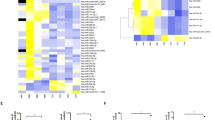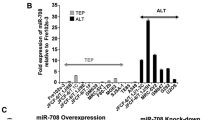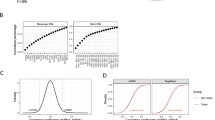Abstract
Multiple myeloma (MM) is characterized by the clonal proliferation of malignant plasma cells and refractoriness to traditional therapies. It has been shown that exosomes are involved in modulating the progression and the metastasis of cancers through microRNAs (miRs). Ceramide is a type of sphingolipid; the ceramide pathway of exosomal secretion has been shown to affect the apoptosis of cancer cells. But the role of this pathway in MM cell function, exosome function and miR regulation remains unknown. In this study, we showed that C6 ceramide (an exogenous ceramide supplement, 1.25–40 μmol/L) dose-dependently inhibited the proliferation and promoted the apoptosis in human MM OPM2 cell line, which were associated with elevated caspase 3/9 and PARP cleavage. We also found that C6 ceramide (5–20 μmol/L) dose-dependently stimulated exosome secretion and increased exosomal levels of tumor-suppressive miRs (miR 202, miR 16, miR 29b and miR 15a). Of note, exosomes from C6 ceramide-treated OPM2 cells could influence the proliferation and apoptosis of the recipient OPM2 cells, which correlated with increased tumor-suppressive exosomal miRs. In contrast, GW4869 (a ceramide inhibitor, 5–20 μmol/L) exerted the opposite effects on the regulation of MM function, exosome secretion and miR levels in MM exosomes. However, exosomes from GW4869-treated OPM2 cells had no effect on these miRs and the survival of targeted OPM2 cells. Taken together, our findings reveal that the ceramide pathway modulates MM survival, probably directly via the caspase pathway and indirectly via exosomal miR mechanisms.
Similar content being viewed by others
Log in or create a free account to read this content
Gain free access to this article, as well as selected content from this journal and more on nature.com
or
References
Raab MS, Podar K, Breitkreutz I, Richardson PG, Anderson KC . Multiple myeloma. Lancet 2009; 374: 324–39.
Sabattini E, Bacci F, Sagramoso C, Pileri SA . WHO classification of tumours of haematopoietic and lymphoid tissues in 2008: an overview. Pathologica 2010; 102: 83–7.
Brenner H, Gondos A, Pulte D . Recent major improvement in long-term survival of younger patients with multiple myeloma. Blood 2008; 111: 2521–6.
Chung C . Role of immunotherapy in targeting the bone marrow microenvironment in multiple myeloma: an evolving therapeutic strategy. Pharmacotherapy 2017; 37: 129–43.
Wang Z, Chen JQ, Liu JL, Tian L . Exosomes in tumor microenvironment: novel transporters and biomarkers. J Transl Med 2016; 14: 297.
Munson P, Shukla A . Exosomes: potential in cancer diagnosis and therapy. Medicines (Basel) 2015; 2: 310–27.
Wu CY, Du SL, Zhang J, Liang AL, Liu YJ . Exosomes and breast cancer: a comprehensive review of novel therapeutic strategies from diagnosis to treatment. Cancer Gene Ther 2017; 24: 6–12.
Wang J, Guo R, Yang Y, Jacobs B, Chen S, Iwuchukwu I, et al. The novel methods for analysis of exosomes released from endothelial cells and endothelial progenitor cells. Stem Cells Int 2016; 2016: 2639728.
Wang Y, Cheng Q, Liu J, Dong M . Leukemia stem cell-released microvesicles promote the survival and migration of myeloid leukemia cells and these effects can be inhibited by microRNA34a overexpression. Stem Cells Int 2016; 2016: 9313425.
Trajkovic K, Hsu C, Chiantia S, Rajendran L, Wenzel D, Wieland F, et al. Ceramide triggers budding of exosome vesicles into multivesicular endosomes. Science 2008; 319: 1244–7.
Wang G, Dinkins M, He Q, Zhu G, Poirier C, Campbell A, et al. Astrocytes secrete exosomes enriched with proapoptotic ceramide and prostate apoptosis response 4 (PAR-4): potential mechanism of apoptosis induction in Alzheimer disease (AD). J Biol Chem 2012; 287: 21384–95.
Zhang J, Alter N, Reed JC, Borner C, Obeid LM, Hannun YA . Bcl-2 interrupts the ceramide-mediated pathway of cell death. Proc Natl Acad Sci U S A 1996; 93: 5325–8.
Coe GL, Redd PS, Paschall AV, Lu C, Gu L, Cai H, et al. Ceramide mediates FasL-induced caspase 8 activation in colon carcinoma cells to enhance FasL-induced cytotoxicity by tumor-specific cytotoxic T lymphocytes. Sci Rep 2016; 6: 30816.
Kitatani K, Usui T, Sriraman SK, Toyoshima M, Ishibashi M, Shigeta S, et al. Ceramide limits phosphatidylinositol-3-kinase C2beta-controlled cell motility in ovarian cancer: potential of ceramide as a metastasis-suppressor lipid. Oncogene 2016; 35: 2801–12.
Kong JN, He Q, Wang G, Dasgupta S, Dinkins MB, Zhu G, et al. Guggulsterone and bexarotene induce secretion of exosome-associated breast cancer resistance protein and reduce doxorubicin resistance in MDA-MB-231 cells. Int J Cancer 2015; 137: 1610–20.
Ji C, Yang B, Yang YL, He SH, Miao DS, He L, et al. Exogenous cell-permeable C6 ceramide sensitizes multiple cancer cell lines to Doxorubicin-induced apoptosis by promoting AMPK activation and mTORC1 inhibition. Oncogene 2010; 29: 6557–68.
Zhang F, Yang J, Li H, Liu M, Zhang J, Zhao L, et al. Combating rituximab resistance by inducing ceramide/lysosome-involved cell death through initiation of CD20-TNFR1 co-localization. Oncoimmunology 2016; 5: e1143995.
Iguchi Y, Eid L, Parent M, Soucy G, Bareil C, Riku Y, et al. Exosome secretion is a key pathway for clearance of pathological TDP-43. Brain 2016; 139: 3187–201.
Essandoh K, Yang L, Wang X, Huang W, Qin D, Hao J, et al. Blockade of exosome generation with GW4869 dampens the sepsis-induced inflammation and cardiac dysfunction. Biochim Biophys Acta 2015; 1852: 2362–71.
Zhang YK, Wang H, Leng Y, Li ZL, Yang YF, Xiao FJ, et al. Overexpression of microRNA-29b induces apoptosis of multiple myeloma cells through down regulating Mcl-1. Biochem Biophys Res Commun 2011; 414: 233–9.
Li Y, Zhang B, Li W, Wang L, Yan Z, Li H, et al. MiR-15a/16 regulates the growth of myeloma cells, angiogenesis and antitumor immunity by inhibiting Bcl-2, VEGF-A and IL-17 expression in multiple myeloma. Leuk Res 2016; 49: 73–9.
Shen X, Guo Y, Yu J, Qi J, Shi W, Wu X, et al. miRNA-202 in bone marrow stromal cells affects the growth and adhesion of multiple myeloma cells by regulating B cell-activating factor. Clin Exp Med 2016; 16: 307–16.
Thind A, Wilson C . Exosomal miRNAs as cancer biomarkers and therapeutic targets. J Extracell Vesicles 2016; 5: 31292.
Kosaka N, Iguchi H, Yoshioka Y, Takeshita F, Matsuki Y, Ochiya T . Secretory mechanisms and intercellular transfer of microRNAs in living cells. J Biol Chem 2010; 285: 17442–52.
Coe GL, Redd PS, Paschall AV, Lu C, Gu L, Cai H, et al. Ceramide mediates FasL-induced caspase 8 activation in colon carcinoma cells to enhance FasL-induced cytotoxicity by tumor-specific cytotoxic T lymphocytes. Sci Rep 2016; 6: 30816.
Flowers M, Fabrias G, Delgado A, Casas J, Abad JL, Cabot MC . C6-ceramide and targeted inhibition of acid ceramidase induce synergistic decreases in breast cancer cell growth. Breast Cancer Res Treat 2012; 133: 447–58.
Wu M, Harvey KA, Ruzmetov N, Welch ZR, Sech L, Jackson K, et al. Omega-3 polyunsaturated fatty acids attenuate breast cancer growth through activation of a neutral sphingomyelinase-mediated pathway. Int J Cancer 2005; 117: 340–8.
Jiang F, Jin K, Huang S, Bao Q, Shao Z, Hu X, et al. Liposomal C6 ceramide activates protein phosphatase 1 to inhibit melanoma cells. PLoS One 2016; 11: e159849.
Zhang Y, Shen XJ, Wu XH, Cong H, Ni HB, Ju SQ, et al. miR-202 contributes to sensitizing MM cells to drug significantly via activing JNK/SAPK signaling pathway. Zhonghua Xue Ye Xue Za Zhi 2016; 37: 987–92.
Zhang L, Pan L, Xiang B, Zhu H, Wu Y, Chen M, et al. Potential role of exosome-associated microRNA panels and in vivo environment to predict drug resistance for patients with multiple myeloma. Oncotarget 2016; 7: 30876–91.
De Veirman K, Wang J, Xu S, Leleu X, Himpe E, Maes K, et al. Induction of miR-146a by multiple myeloma cells in mesenchymal stromal cells stimulates their pro-tumoral activity. Cancer Lett 2016; 377: 17–24.
Acknowledgements
This study was supported by the National Natural Science Foundation of China (No 81470361 and 81670203) and Tian-Qing Program (No B16416-20160824) to Jing LIU; the CSC Scholarship (No 201706370184) and the Innovative Research Funds for the Central South University to Qian CHENG (No 2016zzts151).
Author information
Authors and Affiliations
Corresponding author
Additional information
Supplementary information is available at the website of Acta Pharmacologica Sinica.
Supplementary information
Supplementary Information
Supplementary Figure S1 (JPG 92 kb)
Supplementary Table S1
The RT and qPCR primers used in this study. (DOC 34 kb)
Rights and permissions
About this article
Cite this article
Cheng, Q., Li, X., Wang, Y. et al. The ceramide pathway is involved in the survival, apoptosis and exosome functions of human multiple myeloma cells in vitro. Acta Pharmacol Sin 39, 561–568 (2018). https://doi.org/10.1038/aps.2017.118
Received:
Accepted:
Published:
Issue date:
DOI: https://doi.org/10.1038/aps.2017.118
Keywords
This article is cited by
-
Ceramides may Play a Central Role in the Pathogenesis of Alzheimer’s Disease: a Review of Evidence and Horizons for Discovery
Molecular Neurobiology (2025)
-
Ceramide releases exosomes with a specific miRNA signature for cell differentiation
Scientific Reports (2023)
-
Effect of PLA2G6 and SMPD1 Variants on the Lipid Metabolism in the Cerebrospinal Fluid of Patients with Parkinson's Disease: A Non-targeted Lipidomics Study
Neurology and Therapy (2023)
-
The role of Exosomal miRNAs in cancer
Journal of Translational Medicine (2022)
-
Emerging role of exosomes in hematological malignancies
Clinical and Experimental Medicine (2022)



